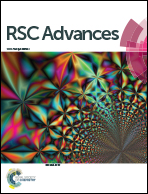PEG functionalized selenium nanoparticles as a carrier of crocin to achieve anticancer synergism
Abstract
Selenium nanoparticles (SeNPs) have garnered a great deal of attention as potential cancer therapeutic payloads. However, the in vivo targeting drug delivery has been challenging. Herein, we describe the synthesis of PEG functionalized SeNPs (PEG-SeNPs) and its use as a cancer-targeted delivery vehicle to achieve enhanced anticancer efficacy. Crocin, a major active product of saffron (dried stigmas of Crocus sativus), having many therapeutic properties was conjugated to PEG-SeNPs. PEG-SeNPs showed pH-mediated crocin release for potential cancer therapy. Crocin conjugated PEG-SeNPs exhibits unprecedented enhanced cytotoxicity toward lung cancer cells through induction of apoptosis. Furthermore, crocin conjugated PEG-SeNPs significantly inhibited in vivo tumor growth in nude mice model. This cancer-targeted design of SeNPs opens a new path for synergistic treating of cancer with higher efficacy and decreased side effects.


 Please wait while we load your content...
Please wait while we load your content...